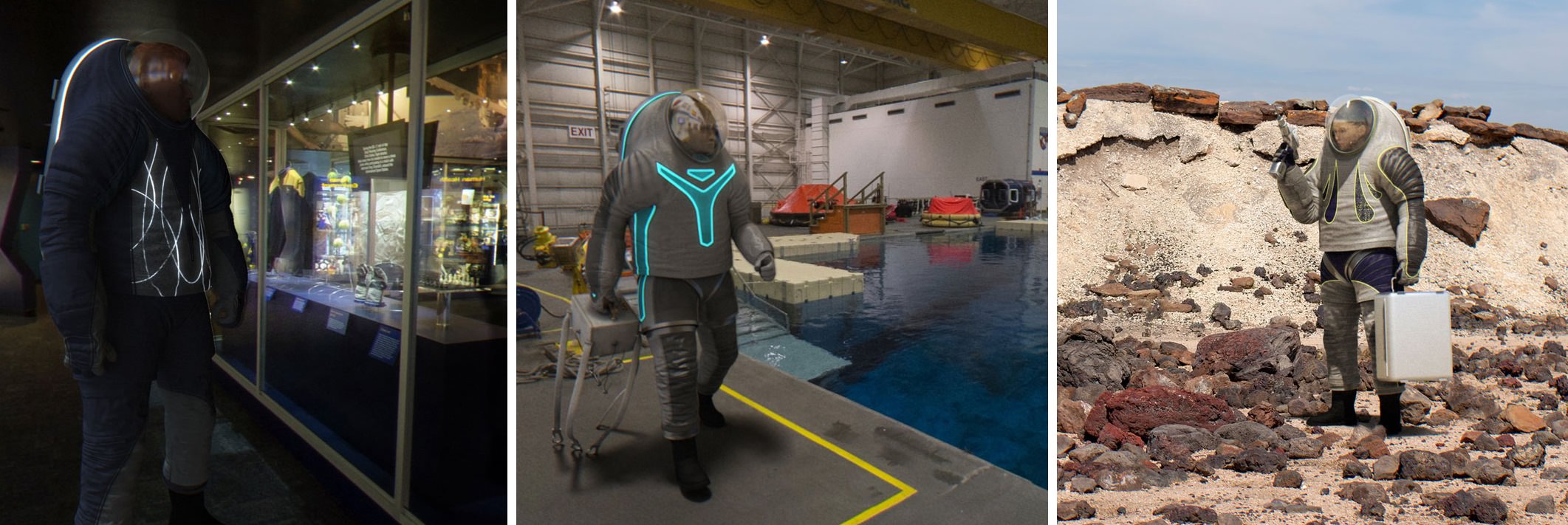If you ever wanted to participate in spacesuit design, even in a small way, here’s your big chance. NASA is asking the public to choose which design of the futuristic Z-2 “planetary mobility” suit prototype will be used by astronauts while evaluating how well the spacesuit works.
There are three options (which you can see above), and NASA promises the winning design will be used in pool training at NASA’s Neutral Buoyancy Laboratory, the Johnson Space Center “rockyard” to simulate Mars exploration, and in vacuum tests. Outer space is not an option because of “micrometeorite, thermal and radiation protection” considerations, however.
In NASA’s words, here’s a quick summary of the prototypes:
- Biomimicry: The “Biomimicry” design draws from an environment with many parallels to the harshness of space: the world’s oceans. Mirroring the bioluminescent qualities of aquatic creatures found at incredible depths, and the scaly skin of fish and reptiles found across the globe, this design reflects the qualities that protect some of Earth’s toughest creatures.
- Technology: “Technology” pays homage to spacesuit achievements of the past while incorporating subtle elements of the future. By using Luminex wire and light-emitting patches, this design puts a new spin on spacewalking standards such as ways to identify crew members.
- Trends In Society: “Trends in Society” is based off of just that: being reflective of what every day clothes may look like in the not too distant future. This suit uses electroluminescent wire and a bright color scheme to mimic the appearance of sportswear and the emerging world of wearable technologies.
The Z-2 includes several improvements over its Z-1 predecessor, which won an invention award from Time magazine in 2012. These include a “hard composite” upper torso that is intended to be more durable, better shoulder and hip joints, and boots that would be more useful on a planet.
To follow developments on the suit in detail, you can check out this page. Voting on the spacesuit designs closes at April 15, 2014 at 11:59 EDT. This is where you can vote.
Other collaborators on the design include ILC (the primary suit vendor) and Philadelphia University.


How will this ‘exposed’ suit be protected from micro meteors if it is mounted on the outside of whatever vehicle or habitat? Will there be a ‘shed’ to protect it? How will this suit be brought inside for maintenance or repair? Through a more standard airlock?
It is my understanding that micro meteorites are not a problem on Mars, they do burn in the atmosphere. And I would guess that suit repair simply is not an option. The suit port itself and the room inside it could probably be used as a more standard airlock in an emergency.
If the suit was enclosed in something to protect it from radiation, temperature extremes, micro meteoroids and assorted space junk, not to mention to protect it from contamination by lunar or martian fines, then it may not be a bad idea with some obvious advantages. But if the suit is just allowed to hang exposed to whatever the universe decides to throw at it, bad idea.
Ok. Where did we get these designs from, Adventure Time?
I can understand that a space suit without a “neck” is more practical. But there should at least be some colored stripes or something to help us not think that they are headless. All these designs look like horrible hunchbacks. The random spangle on the chest doesn’t help. NASA needs to consult some French or Italian designer to make this pretty:
“- Milano, this is Houston, we have a problem!”